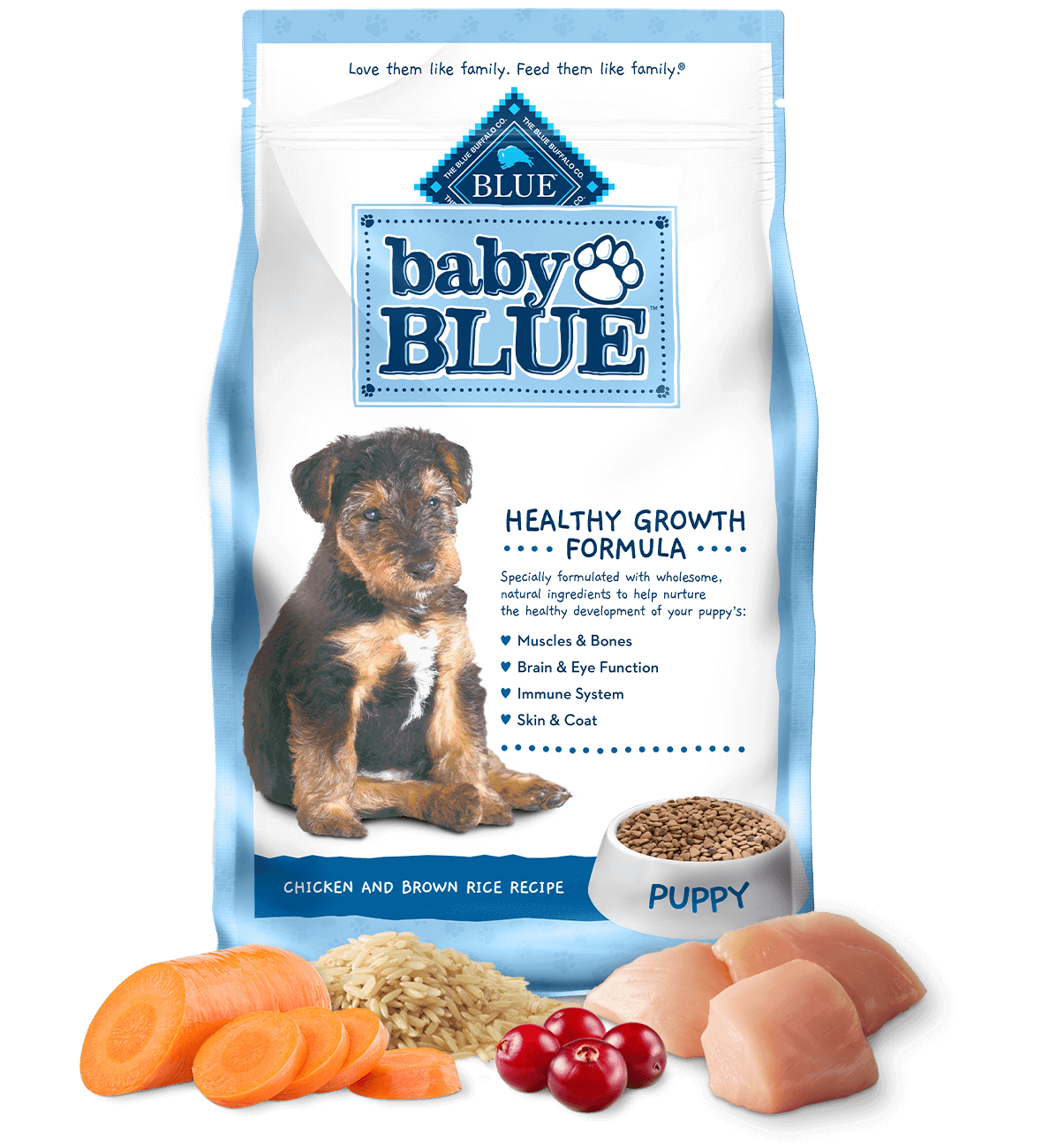
DogFoodAdvisor is reader supported See how
All reviews are 100% impartial but if you buy using links on this page, we may earn a referral fee.
Our Verdict
Blue Buffalo Baby BLUE dry range is made up of four recipes which each receive the Dog Food Advisor’s rating, 5 stars.
This product line is formulated with essential vitamins and nutrients, including DHA, to support the optimal health and development of growing puppies.
Pros
- Quality chicken as the first ingredient
- No artificial flavors or preservatives
- Formulated with veterinarians and animal nutritionists
Cons
- A little on the expensive side
The table below shows each recipe in this range including our rating and the AAFCO nutrient profile: Growth (puppy), Maintenance (adult), All Life Stages, Supplemental or Unspecified.
| Product line | Rating | AAFCO |
|---|---|---|
| Blue Buffalo Baby BLUE Healthy Growth Chicken and Brown Rice | 5 | G |
| Blue Buffalo Baby BLUE High-Protein Healthy Growth Savory Chicken | 5 | G |
| Blue Buffalo Baby BLUE Healthy Growth Chicken and Oatmeal Small Breed | 5 | G |
| Blue Buffalo Baby BLUE Healthy Growth Chicken and Brown Rice Large Breed | 5 | G |
Recipe and Label Analysis
Blue Buffalo Baby BLUE Healthy Growth Chicken and Brown Rice was selected to represent the other products in the line for a detailed recipe and nutrient analysis.
Blue Buffalo Baby BLUE Healthy Growth Chicken and Brown Rice
Estimated Dry Matter Nutrient Content
Protein
Fat
CarbsCarbohydrates
Deboned chicken, chicken meal, brown rice, oatmeal, barley, fish meal (source of omega 3 fatty acids), chicken fat (preserved with mixed tocopherols), dried tomato pomace, peas, natural flavor, flaxseed (source of omega 6 fatty acids), dried egg product, dried yeast, fish oil (source of ARA-arachidonic acid and DHA-docosahexaenoic acid), salt, potassium chloride, choline chloride, direct dehydrated alfalfa pellets, dicalcium phosphate, dried chicory root, alfalfa nutrient concentrate, calcium carbonate, L-threonine, DL-methionine, preserved with mixed tocopherols, vitamin E supplement, dried sweet potatoes, carrots, zinc amino acid chelate, zinc sulfate, vegetable juice for color, ferrous sulfate, iron amino acid chelate, blueberries, cranberries, barley grass, parsley, turmeric, dried kelp, yucca schidigera extract, niacin (vitamin B3), copper sulfate, calcium pantothenate (vitamin B5), L-ascorbyl-2-polyphosphate (source of vitamin C), L-lysine, biotin (vitamin B7), vitamin A supplement, copper amino acid chelate, manganese sulfate, taurine, manganese amino acid chelate, thiamine mononitrate (vitamin B1), riboflavin (vitamin B2), vitamin D3 supplement, vitamin B12 supplement, pyridoxine hydrochloride (vitamin B6), calcium iodate, folic acid (vitamin B9), sodium selenite, oil of rosemary
Fiber (estimated dry matter content) = 5%
Red denotes any controversial items
| Estimated Nutrient Content | |||
|---|---|---|---|
| Method | Protein | Fat | Carbs |
| Guaranteed Analysis | 27% | 16% | NA |
| Dry Matter Basis | 30% | 18% | 44% |
| Calorie Weighted Basis | 26% | 37% | 38% |
Ingredients Analysis
The first ingredient is chicken. Chicken is considered “the clean combination of flesh and skin… derived from the parts or whole carcasses of chicken”. 1
Chicken is naturally rich in the 10 essential amino acids required by a dog to sustain life.
The second ingredient is chicken meal. Chicken meal is considered a meat concentrate and contains nearly 300% more protein than fresh chicken.
The third ingredient is brown rice, a complex carbohydrate that (once cooked) can be fairly easy to digest. However, aside from its natural energy content, rice is of only modest nutritional value to a dog.
The fourth ingredient is oatmeal, a whole-grain product made from coarsely ground oats. Oatmeal is naturally rich in B-vitamins, dietary fiber and can be (depending upon its level of purity) gluten-free.
The fifth ingredient is barley. Barley is a starchy carbohydrate supplying fiber and other healthy nutrients. However, aside from its energy content, this cereal grain is of only modest nutritional value to a dog.
The sixth ingredient is fish meal. Because it is considered a meat concentrate, fish meal contains almost 300% more protein than fresh fish itself.
Fish meal is typically obtained from the “clean, dried, ground tissue of undecomposed whole fish and fish cuttings” of commercial fish operations.2
Unfortunately, this particular item is anonymous. Because various fish contain different types of fats, we would have preferred to have known the source species.
The seventh ingredient is chicken fat. Chicken fat is obtained from rendering chicken, a process similar to making soup in which the fat itself is skimmed from the surface of the liquid.
Chicken fat is high in linoleic acid, an omega-6 fatty acid essential for life. Although it doesn’t sound very appetizing, chicken fat is actually a quality ingredient.
The eighth ingredient is tomato pomace, a by-product remaining after processing tomatoes into juice, soup and ketchup. Many praise tomato pomace for its high fiber and nutrient content, while others believe it’s often used as an inexpensive pet food filler.
As the presence of fiber in a dog’s diet is shown to have great importance, we view the inclusion of tomato pomace in this food as a positive.
The ninth ingredient is peas. Peas are a quality source of carbohydrates. And like all legumes, they’re rich in natural fiber.
However, peas contain about 25% protein, a factor that must be considered when judging the meat content of this dog food.
From here the list goes on to include a number of other items. But to be realistic, ingredients located this far down the list (other than nutritional supplements) are not likely to affect the overall rating of the product.
However, this recipe has five notable exceptions.
First, fish oil. Fish oil is naturally rich in the prized EPA and DHA type of omega-3 fatty acids. These two high-quality fats boast the highest bio-availability to dogs and humans.
Depending on its level of freshness and purity, fish oil should be considered a commendable addition.
Next, flaxseed, one of the best plant sources of healthy omega-3 fatty acids. Provided they’ve first been ground into a meal, flax seeds are also rich in soluble fiber.
However, flaxseed contains about 19% protein, a factor that must be considered when judging the actual meat content of this dog food.
Also, dried yeast, this can be a controversial item. Dried yeast contains about 45% protein and is rich in other healthy nutrients.
Fans believe yeast repels fleas and supports the immune system.
Critics argue yeast ingredients can be linked to allergies. This may be true, but (like all allergies) only if your particular dog is allergic to the yeast itself.
What’s more, a vocal minority insists yeast can increase the risk of developing the life-threatening condition known as bloat. However, this is something we’ve not been able to scientifically verify.
In any case, unless your dog is specifically allergic to it, we feel yeast should be considered a nutritious addition.
This recipe contains sodium selenite, a controversial form of the mineral selenium. Sodium selenite appears to be nutritionally inferior to the more natural source of selenium found in selenium yeast.
Lastly taurine, an important amino acid associated with the healthy function of heart muscle. Although taurine is not typically considered essential in canines, some dogs have been shown to be deficient in this critical nutrient.
We view the presence of taurine in this recipe as a positive addition
Nutrient Analysis
Based on its ingredients alone, Blue Buffalo Baby BLUE Healthy Growth Chicken and Brown Rice looks like an above-average, dry product.
The dashboard displays a dry matter protein reading of 30%, a fat level of 17.8% and an estimated carbohydrate level of 44.2%.
As a group, the brand features a protein content of 32.8% and a mean fat level of 17.8%. Together these figures suggest a carbohydrate content of 41.4% for the overall product line, alongside a fat-to-protein ratio of 55%.
This means this Blue Buffalo Baby BLUE product line contains above-average protein, below-average carbohydrate, and near-average fat, when compared to typical dry dog food.
Blue Buffalo Dog Food Recall History
The following automated list (if present) includes all dog food recalls related to Blue Buffalo through April 2025.
- Blue Buffalo Dog Food Recall Event Number 2 of March 2017 (March 18, 2017)
- Blue Buffalo Dog Food Recall of March 2017 (March 3, 2017)
- Blue Buffalo Dog Food Recall of February 2017 (February 14, 2017)
- Blue Buffalo Dog Food Recall of May 2016 (May 31, 2016)
- Blue Buffalo Dog Chews Recall of November 2015 (November 25, 2015)
- Blue Buffalo Dog Food Recall (October 8, 2010)
You can view a complete list of all dog food recalls since 2009 here.
Our Rating of Blue Buffalo Baby BLUE Dog Food
Blue Buffalo works with veterinarians and animal nutritionists. This product line of Blue Buffalo is certainly worthy of the 5 stars earned in our review as it is packed with quality proteins.
About
Blue Buffalo was officially launched in 2003 by Bill Bishop, who became frustrated with the lack of transparency and poor ingredient quality in commercial dog food at the time. His inspiration came after his beloved Airedale Terrier, Blue, was diagnosed with cancer. Determined to create a better recipe for his dog, Bishop developed his own formula, and thus Blue Buffalo was born.
In 2018, the brand was sold to General Mills Corporation for $8 billion.
Compare Blue Buffalo Baby BLUE Dog Food
How does Blue Buffalo Baby BLUE compare with The Dog Food Advisor's most recommended brands?
A Final Word
The Dog Food Advisor does not accept money, gifts, samples or other incentives in exchange for special consideration in preparing our reviews.
However, we do receive a referral fee from online retailers (like Chewy or Amazon) and from sellers of perishable pet food when readers click over to their websites from ours. This helps cover the cost of operation of our free blog. Thanks for your support.
For more information, please visit our Disclaimer and Disclosure page.





